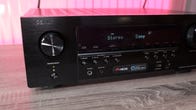Are you looking for the best AV receiver for the money? You’ve come to the right place. I’ve tested most of the popular options from the major brands in the $500 to $800 range, and the connectivity, performance levels and feature sets are impressively high. From 8K video to Dolby Atmos to Wi-Fi music streaming — and high-quality audio — modern home cinema receivers offer everything a home theater enthusiast could need.
The latest such feature is 8K compatibility, which is available on many of the best models we’ve reviewed. Actual 8K video — and 8K TVs — are relatively scarce today, but 8K compatibility could still be important for future-proofing. That is, in case you get an 8K TV in the future — and for gamers with an Xbox Series X or PlayStation 5 who want the latest video features. Such gamers should be aware, however, that until fairly recently, 8K-compatible receivers had issues displaying video from certain types of gaming consoles and PCs.
We’ll explain all of that in-depth below, but first, here are our current picks for best AV receivers of 2022.
Which receiver should I buy?
The Yamaha RX-V6A is my favorite receiver released in the last 12 months. It offers both striking looks and the performance chops to match. It also has plenty of connectivity options including a wealth of HDMI 2.1 ports for connecting the Xbox Series X and more. On that last point, it’s worth noting that until mid-2021 all models were susceptible to a bug making them non-4K/120Hz-compliant, and there may be some of these left on the shelves. However, the company has fixes standing by, as you’ll see below.
If you want to be on the safer side, the Onkyo TX-NR6100 is the receiver to buy. The Onkyo is an excellent performer and offers easy setup, excellent usability, solid looks and useful features, including the best streaming suite. It was never prone to the 4K issue.
Meanwhile, the Denon AVR-S960H also offers 8K throughput and is especially good with music. The downside is that earlier models were also afflicted by the 4K bug, though affected users are able to fix that with a simple, and free, dongle.

 \n ","topic":"","ttag":"","variant":"","viewguid":"","event":"listicle|image|1","correlationId":"","_destCat":"https:\/\/www.amazon.com\/YAMAHA-RX-V6A-7-2-Channel-Receiver-MusicCast\/dp\/B08CKJKKBY","productName":"Best 8K receiver","formatType":"IMAGE","location":"LIST","position":1,"sku":"RX-V6ABL","dwLinkTag":"article-body|listicle|image","selector":"#article-body #listicle-3c1ff726-bbbc-4afd-8770-98ae53453667 .itemImage"}}” rel=”noopener nofollow” target=”_blank”>
\n ","topic":"","ttag":"","variant":"","viewguid":"","event":"listicle|image|1","correlationId":"","_destCat":"https:\/\/www.amazon.com\/YAMAHA-RX-V6A-7-2-Channel-Receiver-MusicCast\/dp\/B08CKJKKBY","productName":"Best 8K receiver","formatType":"IMAGE","location":"LIST","position":1,"sku":"RX-V6ABL","dwLinkTag":"article-body|listicle|image","selector":"#article-body #listicle-3c1ff726-bbbc-4afd-8770-98ae53453667 .itemImage"}}” rel=”noopener nofollow” target=”_blank”>
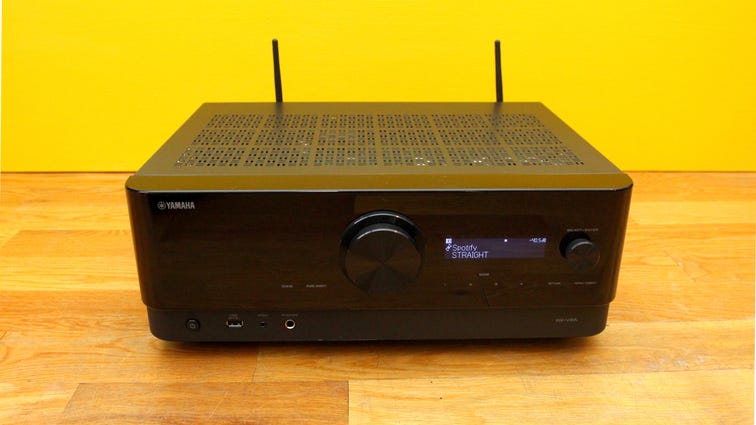

Ty Pendlebury/CNET
This Yamaha AV receiver is the best 8K receiver I’ve tested, but it comes with a caveat. The early 2021 models are not compatible with 4K/120Hz, and we’re still waiting on Yamaha’s 8K board upgrade program to start. Video compliance aside, the Yamaha RX-V6A offers a fresh look at AV receiver design, with its futuristic edges and simple controls, and it also maximizes sound quality. The RX-V6A could even make you forget about visiting a cinema again, and it’s no slouch with music, either. This Yamaha receiver offers Wi-Fi connectivity, AirPlay 2, Spotify Connect, Bluetooth and Yamaha’s MusicCast system for streaming from your devices.

 \n ","topic":"AV Receivers","ttag":"cxity","variant":"","viewguid":"","event":"listicle|image|2","correlationId":"","assettitle":"","campaign":"cxity","cval":59,"leadCpc":0.59,"leadProdPrice":799,"manufacturer":"Onkyo","productName":"Onkyo TX-NR6100","seriesGuid":"35b61b63-4760-4ede-8131-78b1531d6ae3","sku":"TX-NR6100","reviewId":"","formatType":"IMAGE","location":"LIST","position":2,"dwLinkTag":"article-body|listicle|image","selector":"#article-body #listicle-2aff0cc1-3f00-4f78-b907-d673aa34e756 .itemImage"}}” rel=”noopener nofollow” target=”_blank”>
\n ","topic":"AV Receivers","ttag":"cxity","variant":"","viewguid":"","event":"listicle|image|2","correlationId":"","assettitle":"","campaign":"cxity","cval":59,"leadCpc":0.59,"leadProdPrice":799,"manufacturer":"Onkyo","productName":"Onkyo TX-NR6100","seriesGuid":"35b61b63-4760-4ede-8131-78b1531d6ae3","sku":"TX-NR6100","reviewId":"","formatType":"IMAGE","location":"LIST","position":2,"dwLinkTag":"article-body|listicle|image","selector":"#article-body #listicle-2aff0cc1-3f00-4f78-b907-d673aa34e756 .itemImage"}}” rel=”noopener nofollow” target=”_blank”>


Ty Pendlebury/CNET
The TX-NR6100 is the follow-up to my favorite receiver of the past few years, the Onkyo TX-NR696. Like its predecessor, the NR6100 offers great sound and a wealth of connectivity, which now includes support for 4K/120Hz from gaming consoles. It also boasts the best selection of streaming formats, including Chromecast built in, DTS Play-Fi, Spotify Connect, AirPlay and Bluetooth. However, the NR6100 is not quite as good a deal as its predecessor because it now costs $150 more, and the Yamaha RX-V6A offers better performance for less.

 \n ","topic":"AV Receivers","ttag":"amazon","variant":"","viewguid":"","event":"listicle|image|3","correlationId":"","assettitle":"","campaign":"amazon","cval":36,"leadCpc":0.36,"leadProdPrice":738.74,"manufacturer":"Denon","productName":"Denon AVR-S960H","seriesGuid":"0329818f-346d-4f83-8c1e-321a84cbb459","sku":"AVR-S960H","reviewId":"7f8a2acc-a41d-4b95-bb24-017868350ce1","formatType":"IMAGE","location":"LIST","position":3,"dwLinkTag":"article-body|listicle|image","selector":"#article-body #listicle-6b54b7d6-da9e-4c11-905c-ebaaf9e5f29b .itemImage"}}” rel=”noopener nofollow” target=”_blank”>
\n ","topic":"AV Receivers","ttag":"amazon","variant":"","viewguid":"","event":"listicle|image|3","correlationId":"","assettitle":"","campaign":"amazon","cval":36,"leadCpc":0.36,"leadProdPrice":738.74,"manufacturer":"Denon","productName":"Denon AVR-S960H","seriesGuid":"0329818f-346d-4f83-8c1e-321a84cbb459","sku":"AVR-S960H","reviewId":"7f8a2acc-a41d-4b95-bb24-017868350ce1","formatType":"IMAGE","location":"LIST","position":3,"dwLinkTag":"article-body|listicle|image","selector":"#article-body #listicle-6b54b7d6-da9e-4c11-905c-ebaaf9e5f29b .itemImage"}}” rel=”noopener nofollow” target=”_blank”>
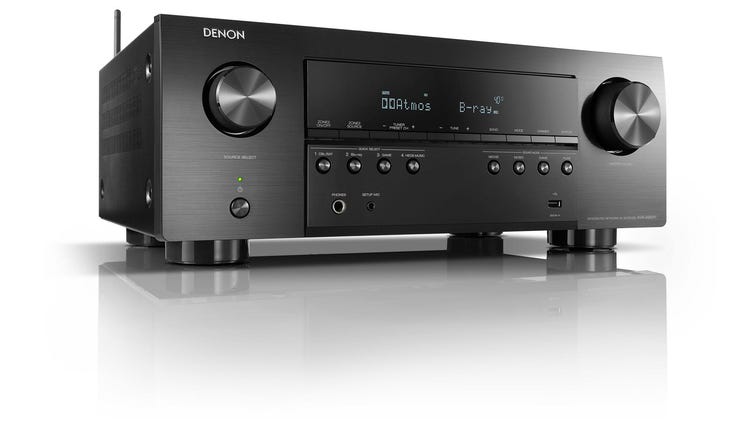

Sound United
One of only two mainstream designs released in 2020, Denon’s AVR-S960H may not be as glittering and shiny as the Yamaha RX-V6A, but it still offers excellent sound quality. The receiver is laid-back, blends well with forward-sounding speakers and replays music beautifully. It has almost everything you need, including 8K video, voice control via both Amazon Alexa and Google Assistant speakers, Dolby Atmos, and Apple AirPlay 2.
Be aware that versions of the Denon AVR-S960H bought before April 2021 are affected by the 4K/120Hz bug and owners should sign up for one of the free dongles.
Should you buy an 8K receiver?
Yes, you’ll want to make sure your new receiver can keep up with the latest TVs and video gear. Standards do change all the time, but the bare minimum right now is support for HDR and Dolby Vision, and at least HDMI version 2.0 or better. All of these models support not only 4K and HDR video but 8K support as well, even if 8K content is hard to find.
Things are a little better now that manufacturers have mostly addressed the early problems with 4K support, but it’s still something to be aware of. You see, all of 2020’s 8K-compatible receivers were prone to a bug preventing them from displaying variable refresh rate video, and from the Xbox Series X in particular. While Denon, Marantz and Yamaha announced fixes for existing models, if you buy a Yamaha RX-V6A right now there may still be a small chance it could need a mainboard replacement. A spokesperson told me that compliant receivers began shipping in the summer, and that affected Yamaha users can check for 4K compatibility here
Sound United, which produces Denon and Marantz receivers, says any models sold after April 2021 should be 4K/120Hz compatible. The spokesperson said that if customers are unsure whether their model is compliant or not, they should contact their dealer or customer support. Older, noncompliant models are able to be rectified with a free adapter, but the company advises these dongles have been out of stock for several months.
Competitor Onkyo released its $599 TX-NR5100 in mid-July 2021, and while I found it could pass 4K/120Hz, I believe it’s not as recommendable as the older, more capable TX-NR696 for the same money. The $799 TX-NR6100 is its true replacement, but it is more expensive.
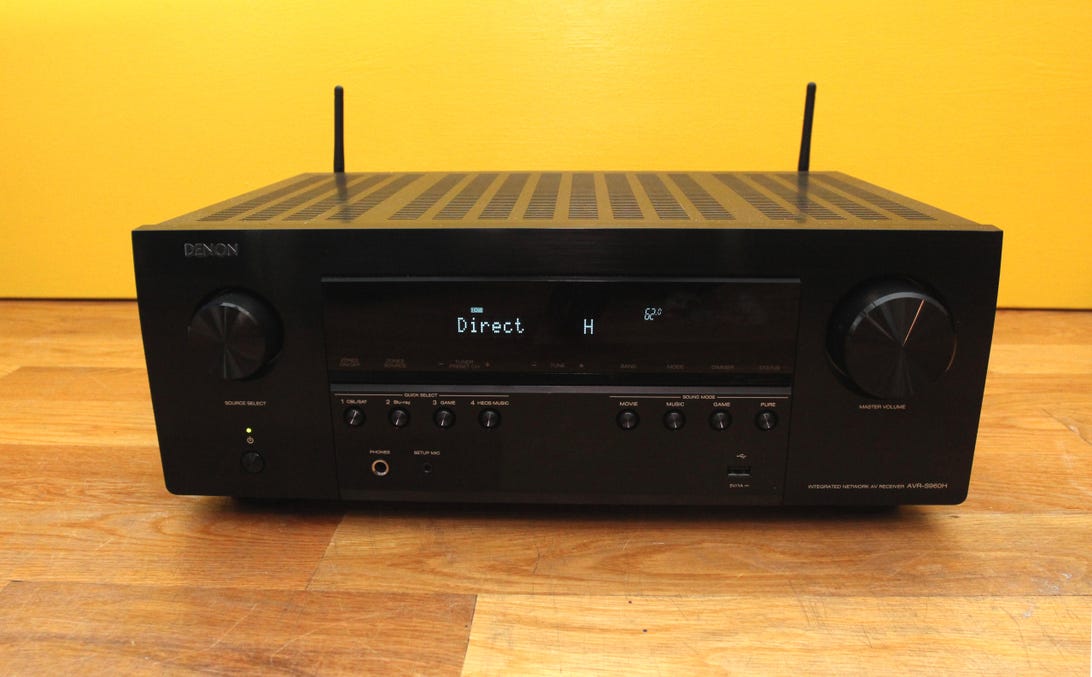
The Denon AVR-S960H
Ty Pendlebury/CNETIs 4K/120Hz support a big deal?
The short answer is: Only if you own an Xbox Series X, and a brand-new TV. As I write this, there are a small handful of Xbox Series X games that support this optional mode — Ori and the Will of the Wisps, Call of Duty: Black Ops Cold War, to name a couple — but the advantages of 4K/120Hz over 60Hz are minimal as far as we’ve seen at this point. Future games and even video sources may make the differences clearer, and that’s why you might want a receiver that’s fully compatible.
If you do buy an older receiver, you don’t care about the Xbox Series X, or don’t want to send your 8K model to the shop, you can always hook a fancy new console directly to the TV, then use eARC to get audio to the receiver. However, despite the mess that AV receiver manufacturers have found themselves in over the last 12 months, there is one thing the aforementioned models have in common: great performance.
Other features to look for in sub-$1K receiver
AV receivers are notoriously complex, with reams of features and confusing technical specifications. (For example, what’s “Ultra HD” anyway?) Yet, what are the things that really matter when buying a new model? I’m going to sum up the most important ones right here.
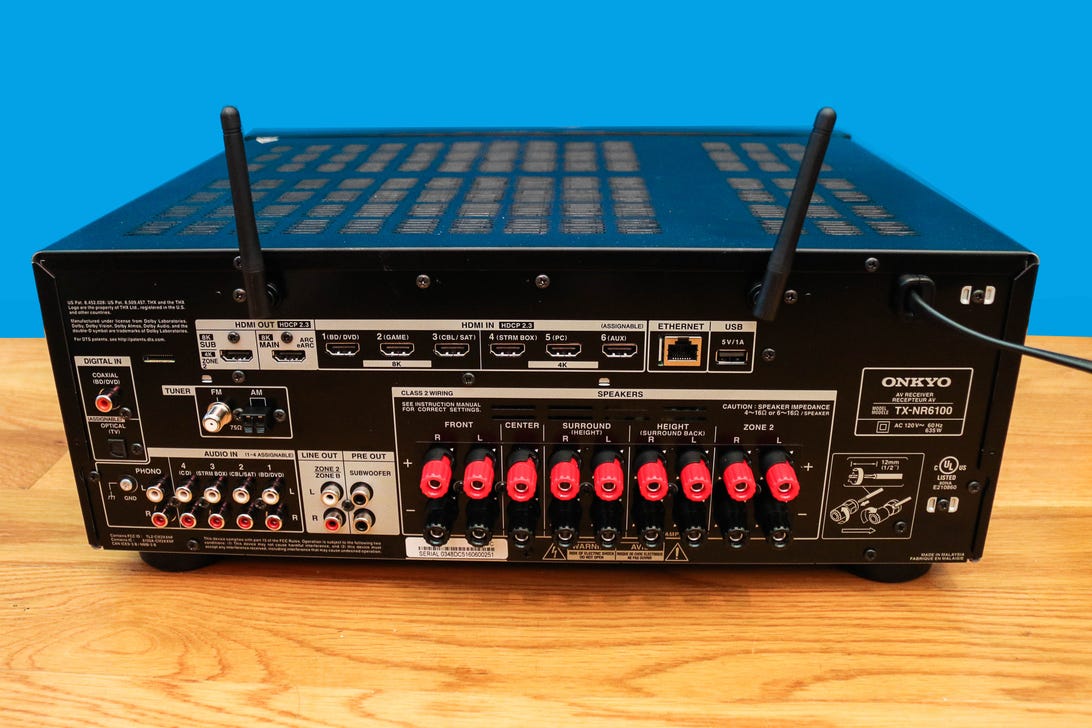

The rear panel of the TX-NR6100 offers 6 HDMI inputs and 2 outputs
Ty Pendlebury/CNETHDMI inputs: As many as you can get
With most TVs and set-top boxes supporting HDMI, you should buy a receiver that has as many of these HDMI input ports and outputs as possible. Front-mounted HDMI ports are kind of like an appendix — unneeded, because most users don’t hot-plug HDMI devices — making the number of rear inputs what’s most important. (How else are you going to connect your Roku, Blu-ray player, Nintendo Switch and all your other devices?) The Onkyo has six rear-mounted HDMI ports, while the Denon and Yamaha go one better with seven. If you want to connect two different displays — a TV and a projector, for example — all but the Yamaha offer a second HDMI output. You should also be sure you have an extra HDMI cable or two on hand — these things are like the second sock of a pair in that you can never find them when you need them.
You don’t really need Dolby Atmos ‘height’ speakers
Most receivers in the $500-and-above price range include Dolby Atmos capability and DTS:X, but the effect they have on your home theater movie-watching can be subtle, or in most movies, nonexistent. In other words, don’t worry about missing out on these formats if you don’t install an extra height speaker or two. Mounting your rear surround speakers high on the wall will get you halfway there in terms of quality, immersive sound.
Wi-Fi music streaming
Most midrange receivers have onboard Wi-Fi network connectivity for wireless music streaming through your speaker system. There are plenty of standards for wireless streaming services, but the most universal are Spotify Connect, Apple AirPlay 1 and 2 and Google Chromecast built in. If you’re looking to build a multiroom system with a variety of AV systems and speakers with wireless connectivity, these are the three flavors to aim for. Onkyo is the only device that supports all three. The Denon receiver model lacks wireless streaming via Chromecast, but ups the ante to AirPlay 2 and the proprietary HEOS system. Meanwhile, Yamaha has its own MusicCast system.
For more general information on what you should be looking for, check out this AV receiver buying guide.
